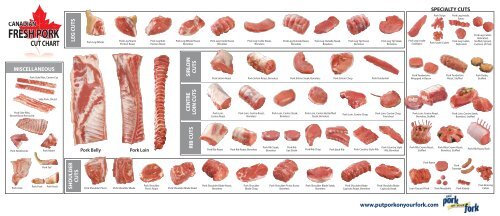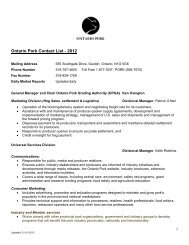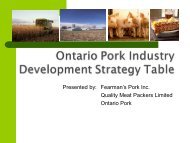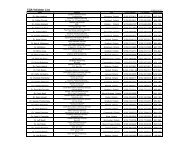Ont Pork cut chart mar8 - Ontario Meat & Poultry
Ont Pork cut chart mar8 - Ontario Meat & Poultry
Ont Pork cut chart mar8 - Ontario Meat & Poultry
Create successful ePaper yourself
Turn your PDF publications into a flip-book with our unique Google optimized e-Paper software.
SPECIALTY CUTS<br />
LEG CUTS<br />
<strong>Pork</strong> Leg Whole<br />
<strong>Pork</strong> Leg Shank<br />
Portion Roast<br />
<strong>Pork</strong> Leg Butt<br />
Portion Roast<br />
<strong>Pork</strong> Leg Whole Roast,<br />
Boneless<br />
<strong>Pork</strong> Leg Inside Roast,<br />
Boneless<br />
<strong>Pork</strong> Leg Inside Steak,<br />
Boneless<br />
<strong>Pork</strong> Leg Outside Roast,<br />
Boneless<br />
<strong>Pork</strong> Leg Outside Steak,<br />
Boneless<br />
<strong>Pork</strong> Leg Tip Roast,<br />
Boneless<br />
<strong>Pork</strong> Leg Tip Steak,<br />
Boneless<br />
<strong>Pork</strong> Leg Inside<br />
Scallopini<br />
<strong>Pork</strong> Strips<br />
<strong>Pork</strong> Sauté Cubes<br />
<strong>Pork</strong> Leg Inside,<br />
Satay<br />
<strong>Pork</strong> Leg Cutlet,<br />
Delicated<br />
<strong>Pork</strong> Leg Cutlet,<br />
Delicated,<br />
Stuffed, Spiced,<br />
Cushion of <strong>Pork</strong><br />
MISCELLANEOUS<br />
<strong>Pork</strong> Side Ribs, Centre Cut<br />
SIRLOIN<br />
CUTS<br />
<strong>Pork</strong> Sirloin Roast <strong>Pork</strong> Sirloin Roast, Boneless <strong>Pork</strong> Sirloin Steak, Boneless <strong>Pork</strong> Sirloin Chop <strong>Pork</strong> Tenderloin<br />
<strong>Pork</strong> Tenderloin,<br />
Wrapped in Bacon<br />
<strong>Pork</strong> Tenderloin<br />
Roast, Stuffed<br />
<strong>Pork</strong> Pattie,<br />
Stuffed<br />
<strong>Pork</strong> Side Ribs,<br />
Breast Bone Removed<br />
Side <strong>Pork</strong>, Sliced<br />
CENTRE<br />
LOIN CUTS<br />
<strong>Pork</strong> Loin,<br />
Centre Roast<br />
<strong>Pork</strong> Loin, Centre Roast,<br />
Boneless<br />
<strong>Pork</strong> Loin, Centre Steak,<br />
Boneless<br />
<strong>Pork</strong> Loin, Centre Butterflied<br />
Steak, Boneless<br />
<strong>Pork</strong> Loin, Centre Chop<br />
<strong>Pork</strong> Loin, Centre Chop,<br />
Frenched<br />
<strong>Pork</strong> Loin, Centre Roast,<br />
Boneless, Stuffed<br />
<strong>Pork</strong> Loin, Centre Steak,<br />
Boneless, Stuffed<br />
<strong>Pork</strong> Neckbones<br />
<strong>Pork</strong> Riblet<br />
<strong>Pork</strong> Belly<br />
<strong>Pork</strong> Loin<br />
RIB CUTS<br />
<strong>Pork</strong> Rib Roast<br />
<strong>Pork</strong> Rib Roast, Boneless<br />
<strong>Pork</strong> Rib Steak,<br />
Boneless<br />
<strong>Pork</strong> Rib<br />
Eye Steak <strong>Pork</strong> Rib Chop <strong>Pork</strong> Back Rib <strong>Pork</strong> Country Style Rib<br />
<strong>Pork</strong> Country Style<br />
Rib, Boneless<br />
<strong>Pork</strong> Rib Crown Roast,<br />
Stuffed<br />
<strong>Pork</strong> Ribs Crown Roast,<br />
Boneless, Stuffed<br />
<strong>Pork</strong> Rib Roast, Rack<br />
<strong>Pork</strong> Jowl<br />
<strong>Pork</strong> Foot<br />
<strong>Pork</strong> Tail<br />
<strong>Pork</strong> Hock<br />
SHOULDER<br />
CUTS<br />
<strong>Pork</strong> Shoulder Picnic<br />
<strong>Pork</strong> Shoulder Blade<br />
<strong>Pork</strong> Shoulder<br />
Picnic Roast<br />
<strong>Pork</strong> Shoulder Blade Roast<br />
<strong>Pork</strong> Shoulder Blade Roast,<br />
Boneless<br />
<strong>Pork</strong> Shoulder<br />
Blade Chop<br />
<strong>Pork</strong> Shoulder Picnic Roast,<br />
Boneless<br />
<strong>Pork</strong> Shoulder Blade Steak,<br />
Boneless<br />
<strong>Pork</strong> Shoulder Blade<br />
Capicola Roast, Boneless<br />
<strong>Pork</strong> Shoulder Blade<br />
Capicola Steak<br />
Lean Ground <strong>Pork</strong><br />
<strong>Pork</strong> Pattie<br />
<strong>Pork</strong> <strong>Meat</strong>balls<br />
<strong>Pork</strong><br />
Sausage<br />
<strong>Pork</strong> Kabob<br />
<strong>Pork</strong> Braising<br />
Cubes<br />
www.putporkonyourfork.com
Fresh Canadian pork consumers are<br />
demanding boneless, well-trimmed<br />
pork products that offer good value for<br />
their dollar. This <strong>chart</strong> offers up-to-date<br />
information about the latest<br />
development in <strong>cut</strong>s, cooking and<br />
nutrition.<br />
<strong>Pork</strong> is lean.<br />
All trimmed <strong>cut</strong>s of pork, except ribs,<br />
qualify as a lean or extra lean source of<br />
protein as recommended by Canada’s<br />
Food Guide.<br />
TRY FRESH<br />
CANADIAN PORK<br />
Characteristics of <strong>Pork</strong> Cuts<br />
<strong>Pork</strong> <strong>cut</strong>s come from four main areas: Loin, Leg, Shoulder and Belly.<br />
A variety of <strong>cut</strong>s are derived from each area.<br />
Loin<br />
The loin forms the back of the carcass. Attached to it are back ribs and<br />
the tenderloin. Once these are removed what is left is the main muscle,<br />
which is divided into three sections: the rib portion (closest to the<br />
shoulder), centre, and sirloin. The loin muscle is very tender and lean<br />
throughout, which is why it yields premium-priced <strong>cut</strong>s. Ideally, loin <strong>cut</strong>s<br />
are cooked by dry heat methods: roasting, grilling or pan frying. (See<br />
Cooking Methods section).<br />
Leg<br />
The leg can be merchandised whole or <strong>cut</strong> into three muscles: inside,<br />
outside and tip. Each of these has its own characteristics, with the inside<br />
being the most tender. The eye forms part of the outside. Leg <strong>cut</strong>s can<br />
be cooked by dry heat methods, particularly in the case of schnitzels,<br />
but are best suited to moist heat methods; braising, for example. Leg<br />
<strong>cut</strong>s are lean, economical and a good choice for marinating.<br />
Shoulder<br />
The shoulder is divided into two sections: the blade and the picnic. The<br />
blade portion (closest to the loin) is the more popular retail <strong>cut</strong>; the<br />
picnic is usually merchandised as economical roasts, chops or is used to<br />
make ground pork and sausages. The capicola is the boneless,<br />
well-trimmed eye of the blade. Moist heat cooking for both <strong>cut</strong>s<br />
produces excellent results, but dry heat cooking can be used as well.<br />
Belly<br />
The belly is the section from which we get side ribs and side bacon as<br />
well as a variety of other further processed pork products such as<br />
pancetta (Italian style bacon) and salt pork.<br />
Specialty Cuts<br />
In addition to the traditional pork roasts, chops and ribs, specialty <strong>cut</strong>s<br />
such as pre-breaded schnitzels, <strong>cut</strong>lets, cubes, strips and stuffed roasts<br />
are becoming more popular.<br />
...AND TASTE<br />
THE DIFFERENCE.<br />
Cooking<br />
<strong>Pork</strong> is full of flavour, tender and very versatile. It has a natural affinity for<br />
a wide variety of accompanying flavours, from assertive BBQ ribs to<br />
subtle herbal accents, as well as the traditional pairing with fruits of all<br />
sorts. The sweet mildness of pork can be adapted to a huge range of<br />
recipes and all cooking styles; your options are as varied as your<br />
imagination allows.<br />
Improved production methods have resulted in leaner pork and no<br />
longer has to be cooked to well-done. For example, loin <strong>cut</strong>s can be<br />
cooked to an internal temperature of 160°F (71°C). Your choice of<br />
cooking method depends on the pork <strong>cut</strong>, personal preference<br />
and time available.<br />
Dry Heat Cooking Methods<br />
Roasting is suitable for larger <strong>cut</strong>s. The meat is cooked uncovered on a<br />
rack in a roasting pan. For best results, cook in a pre-heated oven at a<br />
temperature of 325°F (160°C); the tenderloin can be cooked at 375°F<br />
(190°C).<br />
To check doneness, insert a food thermometer into the centre or<br />
thickest part of the roast away from fat or bone. Remember to allow for<br />
a 5°F (3°C) rise in temperature after removal from the oven, cook<br />
shoulder roasts to an internal temperature of 175°F (80°C), leg and loin<br />
roasts to 160°F (71°C). Cover loosely with foil and let stand 10–15 minutes<br />
before carving. All ground meat, including sausages, must be cooked to<br />
160°F (71°C).<br />
Broiling is suitable for smaller <strong>cut</strong>s. Place pork on a rack in a broiler pan<br />
or shallow baking pan 3” to 5” (7.5 cm to 12.5 cm) from heat. Broil until<br />
pork is brown on one side, turn and broil other side until done. Season<br />
each side after browning.<br />
Pan Frying requires adding oil to a skillet and cooking at high heat until<br />
the surface is golden brown. Reduce heat to medium and cook until<br />
meat is reasonably firm. Use a non-stick skillet to reduce or eliminate<br />
added oil.<br />
Stir-Frying is a form of pan frying. Food is cooked in a wok or skillet<br />
over very high heat with very little oil. Simply toss ingredients rapidly<br />
with a spatula.<br />
Grilling is an excellent, low fat cooking method. Whether grilling steaks,<br />
chops, ribs or roasts, pork will always be moist as long as it is not<br />
overcooked. Pre-heat barbecue to high and then reduce to medium.<br />
Use tongs, not a fork, to turn meat to avoid losing precious juices. When<br />
brushing on sauce, do so in the final 10-15 minutes to eliminate flare-ups<br />
and to prevent sauces containing sugar from caramelizing and burning.<br />
Moist Heat Cooking Methods<br />
Braising is used most often for shoulder and leg <strong>cut</strong>s. Use a small<br />
amount of liquid. Simmer, covered, over low heat or in a 325°F (160°C)<br />
oven. Additional liquid may be added during cooking. <strong>Meat</strong> is ready<br />
when tender and easily pierced with a fork.<br />
Stewing is used for smaller pieces of pork. The meat is seared first very<br />
high heat, then covered with liquid and simmered, over low heat on the<br />
stove top, or in an oven at 325°F (160°C) until the meat is tender.<br />
<strong>Pork</strong> Roasting Guide<br />
These are guidelines only; for greater accuracy use a food thermometer<br />
whenever possible.<br />
min/lb<br />
Cut <strong>Pork</strong> Roast lbs kg @ 325°F<br />
(160°C)<br />
Loin centre, bone in 3–5 1.5–2.2 20–25<br />
rack 3–5 1.5–2.2 20–25<br />
sirloin, boneless 3–4 1.5–1.8 25–30<br />
single loin,<br />
boneless 3–4 1.5–1.8 20–25<br />
rib, boneless 2–4 1.0–1.8 20–25<br />
crown roast 8.0 & up 3.5 & up 10–15<br />
double loin 3–5 1.5–2.2 30–35<br />
Leg inside 3–4 1.5–1.8 20–25<br />
outside 3–4 1.5–1.8 20–25<br />
Shoulder blade, boneless 3–6 1.6–2.7 30–35<br />
picnic, boneless 3–6 1.6–2.7 30–35<br />
blade, bone-in 5 2.2 25–30<br />
picnic, bone-in 5 2.2 25–30<br />
Tenderloin roast at 375°F<br />
(190°C)<br />
3/4-1 375-500 g<br />
25–30<br />
total time<br />
Storage and Handling<br />
Storage Tips<br />
The following are some handy tips for the proper storage of fresh pork.<br />
Keep in mind that these are general guidelines; always read the label and<br />
check “packaged on” or “best before” dates. If properly stored, pork can<br />
be easily frozen for later use and then defrosted in the refrigerator or<br />
microwave.<br />
<strong>Meat</strong> defrosted in the microwave should be cooked immediately.<br />
• <strong>Pork</strong> <strong>cut</strong>s wrapped in plastic can be frozen as purchased for up to two<br />
weeks.<br />
• For prolonged frozen storage use moisture-proof, airtight packaging<br />
to prevent moisture loss and freezer burn; label and date packages.<br />
• Remove as much air as possible from freezer bags before sealing.<br />
• Cover sharp bones with extra protection before wrapping so that<br />
the bones don’t poke a hole through the package.<br />
• Freezer burn is caused by loss of moisture on the food surface. Freezer<br />
burned meat has a dry, discoloured surface, and when cooked, is<br />
tough and tasteless.<br />
• It is not recommended to freeze processed products such as ham.<br />
The “Three C’s” for <strong>Meat</strong> Handling<br />
1. Keep it CLEAN<br />
2. Keep it COLD<br />
3. Keep it COVERED<br />
When in doubt, throw it out! If you discover something in the<br />
refrigerator that you have forgotten about, don’t taste it! If any meat<br />
looks or smells suspicious, throw it out!<br />
<strong>Pork</strong> Storage Time Chart<br />
Fresh <strong>Pork</strong><br />
Refrigerator<br />
Freezer<br />
Product 36-40°F / 2-4°C 0°F / -18°C<br />
(days)<br />
(Months)<br />
Roasts, Steaks, Chops 2–3 8–10<br />
Ground <strong>Pork</strong> 1–2 1–3<br />
Sausage 2–3 2–3<br />
Variety <strong>Meat</strong> 1–2 3–4<br />
Processed <strong>Pork</strong><br />
Refrigerator<br />
Freezer<br />
Product 36-40°F / 2-4°C 0°F / -18°C<br />
(days)<br />
(Months)<br />
Sausage, smoked<br />
dry/semi dry<br />
3–7<br />
1–2<br />
Ham* 3–4 N/R<br />
Bacon* 7 1<br />
Cold Cuts* 3–5 N/R<br />
Leftover<br />
Cooked <strong>Pork</strong>**<br />
4–5 2–3<br />
N/R — Not Recommended<br />
* If vacuum packaged, check manufacturer’s “Best Before” date.<br />
** Leftover cooked pork should be cooled, uncovered, at room temperature,<br />
then covered tightly and refrigerated or placed in a freezer within an hour of<br />
cooking.<br />
Nutrition Profile<br />
Eating Well with Canada’s Food Guide recommends choosing leaner<br />
<strong>cut</strong>s of meat more often. Lean meats, like pork, are an important dietary<br />
source of protein, iron, zinc and B-vitamins.<br />
Protein is important for building, repairing and maintaining body<br />
tissues as well as to keep our immune system strong. <strong>Pork</strong> is a<br />
high-quality protein since it contains all nine essential amino acids.<br />
Essential amino acids must be supplied by the diet because the body<br />
cannot make or store them.<br />
Iron plays a critical role in providing energy, fighting off infections and<br />
in thinking and learning. Iron in meat is better absorbed than iron found<br />
in vegetables.<br />
Zinc is essential for building genetic material, proteins, cell<br />
development as well as fighting infections and keeping your bones<br />
strong.<br />
Vitamin B12 is found only in foods from animals. It helps to build red<br />
blood cells, ensure healthy cell function and nervous tissues.<br />
Vitamin B6 is important for energy production and the central nervous<br />
system.<br />
Thiamin or Vitamin B1 plays a role in digestion as well as building and<br />
maintaining healthy nerves and muscles. <strong>Pork</strong> is the best dietary source<br />
of Thiamin!<br />
Riboflavin or Vitamin B2 helps build and repair body tissues and<br />
maintains healthy skin and eyes.<br />
Nutrition Information<br />
For an average 100 g raw, trimmed serving of pork<br />
Energy................ 139 Cal or 580 kJ<br />
Fat...................... 5.0 g<br />
Protein............... 22 g<br />
Carbohydrate.... 0 g<br />
Lean <strong>Pork</strong> Choices<br />
<strong>Pork</strong> Cut Energy Protein Fat<br />
Carbohydrates<br />
<strong>Pork</strong> Tenderloin 125 Cal (523 kJ) 24 g 2.5 g 0 g<br />
<strong>Pork</strong> Leg Inside 121 Cal (506 kJ) 21 g 3.3 g 0g<br />
<strong>Pork</strong> Loin, Centre* 129 Cal (540 kJ) 23 g 3.6 g 0 g<br />
<strong>Pork</strong> Sirloin* 141 Cal (590 kJ) 22 g 5.3 g 0 g<br />
<strong>Pork</strong> Shoulder Blade 149 Cal (623 kJ) 21 g 6.6 g 0 g<br />
<strong>Pork</strong> Rib Portion 172 Cal (720 kJ) 22 g 8.8 g 0 g<br />
Lean Ground <strong>Pork</strong> 217 Cal (908 kJ) 19 g 15 g 0 g<br />
* boneless<br />
Based on average 100 g raw, trimmed serving.<br />
Source: Canadian Nutrient File, Health Canada, 2005<br />
Fat - 7.5 g/100 g extra lean ground pork, 15 g/100 g lean ground pork.<br />
Canadians often consider chicken breast to be their only lean<br />
choice. However, pork tenderloin is as lean as boneless, skinless<br />
chicken breast. In fact, there are a variety of pork <strong>cut</strong>s that are<br />
leaner than boneless, skinless chicken thigh.













